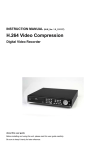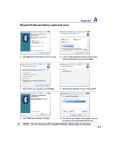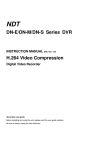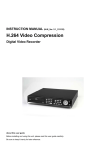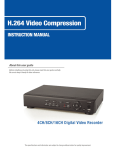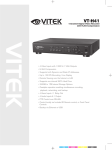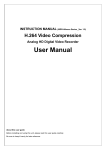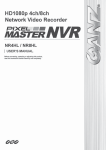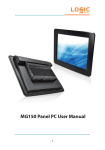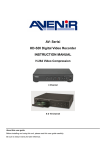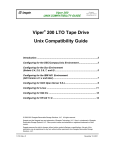Download KX Series Manual - Promax Security Systems
Transcript
INSTRUCTION MANUAL (S_Ver. 1.0_090530_N) H.264 Video Compression Digital Video Recorder About this user guide Before installing and using this unit, please read this user guide carefully. Be sure to keep it handy for later reference. Safety Precautions Explanation of Graphical Symbols This symbol indicates the presence of important operating and maintenance (servicing) instructions in the literature accompanying the product. This symbol indicates the presence of uninsulated ”dangerous voltage” within the product’s enclosure that may be of sufficient magnitude to constitute a risk of electric shock to persons. WARNING To reduce a risk of fire or electric shock, do not expose this product to rain or moisture. CAUTION Changes or modifications not expressly approved by the manufacturer may void the user’s authority to operate this equipment. CAUTION Danger of explosion if battery is incorrectly replaced. Replace only with the same or equivalent type recommended by the manufacturer. Discard used batteries according to the manufacturer’s instructions. These precautions must be followed for safety 2 G G reasons. Warning ! Do not use if the unit emits smoke, strange sounds are heard, or odor is emitted. ! Make sure the power cable is not damaged. ! Make sure there is no dust accumulation on the power plug or the outlet. ! Disassembly prohibited ! Do not place any foreign objects inside the unit. ! Do not place a container holding water or other liquids above the unit when it is connected to power. ! Do not allow the unit to get wet. ! Do not use during thunder/thunder storms. ! Do not place in an unstable position. ! Do not expose to shock or vibration. ! Do not use this unit in areas where it is exposed to the possibility of explosion. Caution ! Do not pull on the power cable when removing the power plug from the outlet. ! Do not touch the power plug with wet hands. ! Do not sit on. ! Make sure the cables are connected properly. ! Do not place heavy objects on connected units. ! Never move this unit while the power is turned on. ! Remove the power plug from the outlet when the unit is going to remain unused for long periods of time. ! Do not block the cooling fans or air ducts. ! Do not expose to extreme temperatures or humidity changes. 3 Warning Installation and servicing should be performed only by qualified and experienced personnel. Turn off the power of the DVR when connecting cameras, audio or sensor cables. The manufacturer is not responsible for any damage caused by improper use of the product or failure to follow instructions for the product. The manufacturer is not responsible for any problems caused by or resulting from the user physically opening the DVR for examination or attempting to fix the unit. The manufacturer may not be held liable for any issues with the unit if the warranty seal is removed. GG 4 G G Rack Mount Instructions The following or similar rack-mount instructions are included with the installation instructions: A) Elevated Operating Ambient - If installed in a closed or multi-unit rack assembly, the operating ambient temperature of the rack environment may be greater than room ambient. Therefore, consideration should be given to installing the equipment in an environment compatible with the maximum ambient temperature (Tma) specified by the manufacturer. B) Reduced Air Flow - Installation of the equipment in a rack should be such that the amount of air flow required for safe operation of the equipment is not compromised. C) Mechanical Loading - Mounting of the equipment in the rack should be such that a hazardous condition is not achieved due to uneven mechanical loading. D) Circuit Overloading - Consideration should be given to the connection of the equipment to the supply circuit and the effect that overloading of the circuits might have on over current protection and supply wiring. Appropriate consideration of equipment nameplate ratings should be used when addressing this concern. E) Reliable Earthing - Reliable earthing of rack-mounted equipment should be maintained. Particular attention should be given to supply connections other than direct connections to the branch circuit (e.g. use of power strips)." 5 Product Components The package contains the main unit and its components as specified below. When you purchase the unit, Please check to ensure the components specified below are included. DVR Set DVD-RW Client Software CD Remote Control Battery1.5V (AAA x 2EA) User Guide HDD & DVD-RW cable (Refer to below table) HDD power cable (Refer to below table) HDD mounting bracket & Screw (Refer to below table) DVD-RW mounting bracket & Screw (Refer to below table) HDD & DVD-RW fixing screw (Refer to below table) Rack mount (2EA) & Screw (6EA) -(Option) Power Cable (110V or 220V)(1EA) 6 G G ,WHPV &+'95 '9'5:YHUVLRQ %DVLFYHUVLRQ +''GDWDFDEOH ($ ($ +''SRZHUFDEOH ($ '9'5:FDEOH ; +''PRXQWLQJEUDFNHW ($ ($ 0RXQWLQJEUDFNHWVFUHZ ($ ($ '9'5:PRXQWLQJEUDFNHW ($ 0RXQWLQJEUDFNHWVFUHZ ($ +'''9'5:IL[LQJVFUHZ ($ ; ($ &+'95 ,WHPV '9'5:YHUVLRQ %DVLFYHUVLRQ +'' +'' +'' +'' +''GDWDFDEOH +''SRZHUFDEOH [ [ [ [ '9'5:GDWDFDEOH [ [ +''PRXQWLQJ %UDFNHWIRU+'' EUDFNHW %UDFNHWIRU+'' [ [ [ +''*URPPHWIL[LQJVFUHZ +''*URPPHW '9'5:PRXQWLQJEUDFNHW [ [ '9'5:PRXQWLQJEUDFNHWVFUHZ [ [ +DQJHU [ [ [ +'''9'5:EUDFNHWIL[LQJVFUHZ 7 Video Signal Select & RS-422/485 Settings Video mode NTSC PAL RS-422/485 Select 485 422 RS-485 Termination ON OFF On the 4ch DVR NOTICE Do not change the setting when the power is on. When the switch is changed, the DVR should be rebooted to apply the new setting. 8 G G Basic key function of the MOUSE ¢ Left button: SELECT function £ Right button: ESC function ¢ : Double click: Go to sub menu 9 Mounting the DVD-RW 1. Unfasten the cover of the unit. 2. Fix the DVD-RW mounting bracket to the DVD-RW using the mounting bracket screws and fix the DVDRW to the unit using the DVD-RW fixing screws. 3. Connect the DVD-RW cable to the both of DVD-RW and main board. 10 G G Mounting the HARD DISK 1. Unfasten the cover of the unit. 2. Fix the supplied HDD mounting bracket to the hard disk using the supplied mounting bracket screws. 3. Connect the supplied SATA cable and power cable to the hard disk and fix the hard disk to the unit using the supplied HDD fixing screws. 11 Compatible HDD Models 6HDJDWH 67696XUYHLOODQFH 7% 530 0% 6HDJDWH 676&( *% 530 0% 6HDJDWH 67$6%DUUDFXGD *% 530 0% 6HDJDWH 67696XUYHLOODQFH *% 530 0% 6HDJDWH 67$6%DUUDFXGD *% 530 0% 6HDJDWH 67$6%DUUDFXGD *% 530 0% 6HDJDWH 67$6%DUUDFXGD *% 530 0% 6HDJDWH 67$6%DUUDFXGD *% 530 0% 6HDJDWH 67$6%DUUDFXGD 7% 530 0% +,7$&+, +'6./$ 7% 530 0% +,7$&+, +'3*/$ *% 530 0% +,7$&+, +'76/$ *% 530 0% +,7$&+, +'76/$ 7% 530 0% :HVWHUQ'LJLWDO :'($&6 7% 530 0% :HVWHUQ'LJLWDO :'$$&6 *% 530 0% :HVWHUQ'LJLWDO :'$$.6 *% 530 0% NOTICE The brands and models of all HDD should be the same. If the brands and models of each HDD are different with others, the DVR may not recognize HDD. Specifications 12 G G ,7(0 &KDQQHO,QSXW/HYHO ,QSXW 9LGHR $ODUP &+ &+ &RPSRVLWH &+ &RPSRVLWH &+ &RPSRVLWH 176&3$/ 9LGHR/RVV&KHFN <HV 0DLQ0RQLWRU2XWSXW &+%1&&+9*$ (XGA : 1024 x 768) 6LJQDO)RUPDW 176&3$/9*$ /RRS &+ &+ 6SRW &+ &+ ,QSXW2XWSXW &+/LQHLQSXW&+/LQHRXWSXW $XGLR&RGHF *$'3&0 6HQVRU,QSXW1&126HOHFWDEOH $ODUP2XWSXW &RPSUHVVLRQ + 0XOWLRSHUDWLRQ 48$'3/(;3OD\EDFN5HFRUG1HWZRUN%DFNXS 176& 5HVROXWLRQ 5HFRUG 'LVSOD\ &+ 6LJQDO)RUPDW 2XWSXW $XGLR &+ 3$/ [ [ [ [ [ [ [ [ [ [ [ [ [ [ [ [ [ [ 5HFRUGLQJTXDOLW\JUDGH 1(7:25.(&2120<1250$/+,*+),1( 5HFRUGLQJ0RGH &RQWLQXRXV6FKHGXOH0RWLRQ6HQVRU0DQXDO 0RWLRQ'HWHFWLRQ 0RWLRQGHWHFWLRQVHWXSE\*ULG 3UH5HFRUGLQJ ISVIRUVHFRQGVEHIRUHDQHYHQW 3RVW5HFRUGLQJ VHFRQGVWRPLQXWHVDIWHUDQHYHQW )UDPH5DWH6HF 176&ISVFKILHOGV3$/ISVFKILHOGV 0XOWL'HFRGLQJ 3OD\EDFN 3OD\EDFN6SHHG 6LQJOHFKDQQHO Ő 0XOWLFKDQQHOV Ő 6HDUFK0RGH 7LPHOLQH(YHQW$UFKLYH/RJ ,QWHUIDFH7\SH 6HULDO$7$, &DSDFLW\RI +'' 6WRUDJH 7% +'' ,QWHUQDO+''1R :2'9'5: :2'9'5: :2'9'5: )LOHV\VWHP %DFNXS 1D)6 86%)ODVKGULYH 9LGHR6WLOO,PDJH 13 %XLOWLQ'9'5: 9LGHR6WLOO,PDJH 1HWZRUN 9LGHR6WLOO,PDJH 0HQX'LVSOD\ 8VHU,) ,QSXW0HWKRG *8, )URQWNH\EXWWRQV5HPRWHFRQWURO0RXVH.H\ERDUG FRQWUROOHU &RQVROH 6HULDOSRUW 1HWZRUN 1HWZRUN $FFHVV )HDWXUHV 3RZHU VRXUFH 56&SLQ'68%FRQQHFWRU 37=FRQWURO.H\ERDUG'95FRQWURO 56 7HUPLQDWLRQ <HV 5656 <HV '\QDPLF'16 <HV)UHH''16 1HWZRUN,QWHUIDFH EDVH7;(WKHUQHW5- &OLHQW6RIWZDUH /LYH6HDUFK%DFNXS37=)&DPHUD&RQWURO :HEYLHZHU /LYH6HDUFK%DFNXS37=)&DPHUD&RQWURO7%'IRU&+ 0XOWLVLWHV0RQLWRULQJ6\VWHPQ /LYH6HDUFK%DFNXS37=)&DPHUD&RQWURO '/6'D\/LJKW6DYLQJ <HV ,QWHUQDO%HHS %\$ODUP0RWLRQ9LGHR/RVV+''HUURU 0XOWL/DQJXDJH <HV 6:8SJUDGH 86%)ODVKGULYH (YHQW,QWHQVLYH5HFRUG 173 <HV 326$70 <HV :DWHUPDUN <HV([FOXVLYHYLHZHUVXSSRUW 3RZHU6XSSO\9ROWDJH '&9$ $OORZDEOHRSHUDWLRQWHPSHUDWXUH'XULQJRSHUDWLRQ 8QLW:HLJKW*URVVZHLJKW .JV.JV /EV/EV PP[PP 8QLW'LPHQVLRQ:[+[' 'LPHQVLRQ $&99+]: &&'XULQJVWRUDJH&& $OORZDEOHRSHUDWLRQKXPLGLW\ :HLJKW <HV [PP [[ .JV.JV/EV/EV PP[PP[PP [[ Please note that specifications and unit exterior design are subject to change without notification Table of Contents 14 G G 1. Main Features....................................................................................................................16 2. Name, Function and Connection........................................................................................ 20 2-1. Front Panel...................................................................................................................................20 2-2. Rear Panel ...................................................................................................................................22 2-3. Remote control .............................................................................................................................24 3. Setting up the DVR ............................................................................................................25 3-1. Setup – Main Screen ....................................................................................................................25 3-2. Setup – Display Mode ..................................................................................................................27 3-3. Setup – Recording Mode ..............................................................................................................29 3-3-1. Recording Schedules ................................................................................................................31 3-4. Setup – Device Mode ...................................................................................................................32 3-4-1. ALARM-OUT .............................................................................................................................33 3-4-2. SPOT – OUT.............................................................................................................................34 3-4-3 PTZ Setup..................................................................................................................................34 3-4-4. Motion Zone Setup ....................................................................................................................35 3-5. Setup – Storage Mode..................................................................................................................36 3-6. Setup – System Mode ..................................................................................................................37 3-7. Setup – SECURITY Mode ............................................................................................................41 3-8. Setup – Network Mode .................................................................................................................42 3-8-1. Ports..........................................................................................................................................44 3-8-2. Network Types ..........................................................................................................................44 3-8-2-1. LAN........................................................................................................................................44 3-8-2-2. DHCP.....................................................................................................................................45 3-8-2-3. ADSL (PPPoE) .......................................................................................................................46 3-8-3. Saving Setup of Network setup .................................................................................................46 3-9. Setup - CONFIG Mode .................................................................................................................47 4. Saving Setup .....................................................................................................................49 5. Live, Search, and Playback ...............................................................................................50 5-1. Live Viewing Screen .....................................................................................................................50 5-2. SEARCH Screen ..........................................................................................................................53 5-2-1. TIME-LINE Search ....................................................................................................................54 5-2-2. Event Search.............................................................................................................................54 5-2-3. Go To First Time ........................................................................................................................55 5-2-4. Go To Last Time ........................................................................................................................55 5-2-5. Go To Specific Time...................................................................................................................56 5-2-6. Log Search................................................................................................................................56 5-2-7. Archive Search ..........................................................................................................................56 5-3. Play mode ....................................................................................................................................57 15 6. PTZ Control .......................................................................................................................58 7. Back up .............................................................................................................................61 7-1. Still Image backup onto USB flash memory or CD(DVD) media ...................................................61 7-2. Video backup onto USB flash memory or CD media.....................................................................61 7-3. Transferring still images or video from the ARCHIVE list ..............................................................62 7-4. Playback of Backup Video ............................................................................................................63 8. Upgrading Firmware ..........................................................................................................64 9. Network access using the Exclusive network viewer.......................................................... 65 9-1. PC requirements ..........................................................................................................................65 9-2. Installing the network viewer.........................................................................................................65 9-3. Live monitoring mode and functions. ............................................................................................66 9-4. Bi directional audio .......................................................................................................................68 9-5. Remote search mode and functions .............................................................................................68 9-6. PC System configuration ..............................................................................................................71 10. Network – By an web-browser viewer ................................................................................ 75 APPENDIX: How to connect network........................................................................................ 77 A. How to set IP address of the DVR and open TCP port of the router?............................................77 B. How to access DVR from Remote PC? ........................................................................................79 1. Main Features 16 G G " H.264 Video compression " Quadplex operation (Simultaneous Recording, Playback, Backup, and Networking) " Reliable File system " VGA&CVBS simultaneous display " High quality VGA (1024X768) " Recording speed from 120fps to 480fps " 4channel audio recording " Bi directional audio 17 " Individual channel operation " Motion detection " Automatic video input and video loss detection " Covert camera operation provides enhanced security " Built-in PTZF camera control " Easy and simple user interface " Easy scheduler " Easy software upgrade 18 G G " Instant and convenient backup via USB flash drive, network or DVD-RW " Exclusive file format backup " AVI backup " 1TB SATA hard drive x MAX.4EA " Various ways of network access via Network client software, Web-viewer, CMS and UMS(Multi-site monitoring software) " Free Dynamic DNS 19 2. Name, Function and Connection 2-1. Front Panel The following information will help you toGoperate the front panel controls. Figure 2.1.1. Front panel Table2.1.1. Indication lamps NO. Name A CH1~16 B HDD C RECORD D ALARM E F Description Indicating that the channel is being recorded. Indicating that the system is accessing the hard disk. Indicating that the system is recording video data. Indicating that when sensor(s) is/are triggered or motion is detected. NETWORK Indicating that when Network client connects through the network. BACKUP Indicating that USB or DVD-RW storage device is stored images or video. Table 2.1.2. Front panel buttons NO Name 1 POWER 2 NUMBER Description POWER ON/ OFF Channel keys. For channel 10, press the 0 key. For channel 11, press the +10 and 1 key. For channel 16, press the +10 and 6 key. 3 REW 4 AUDIO Press to rewind the footage in playback mode. Press to select audio mode such as SINGLE, MIX and MUTE. MUTE- All of 4 channels. SINGLE- Highlighted channel only. MIX- All of 4 channels. 4 F/REW Jump/Step backward. In playback mode, the playback position moves 60 seconds backward. 5 FF 6 ALARM Press to fast forward the footage in playback mode. Press to enable/disable ALARM operation. 20 G G 6 F/ADV Jump/Step forward. In playback mode, the playback position moves 60 seconds forward. 7 REC 8 SEARCH 8 9 Press to start or stop manual recording. Press to go to SEARCH menu in live display mode. Press to play/pause the footage in playback mode. SEQ Enable/disable the automatic sequence of display of channels in full screen, quad, 9-split display mode. 10 PTZ Press to control Pan/Tilt/Zoom operations. 11 SETUP 12 BACKUP Press to capture video in jpeg format in live or playback mode. 13 ൖ(LEFT) Press to move left or to change the values in Setup mode. Press to enter SETUP menu. It is also used as the number 4 when entering password. 14 !(UP) Press to move up the menu in Setup mode. It is also used as the number 1 when entering password. 15 ൘(RIGHT) Press to move right or to change the values in Setup mode. It is also used as the number 2 when entering password. 16 "(DOWN) Press to move down the menu in Setup mode. It is also used as the number 3 when entering password. 17 SEL Press to select desired menu item or to store the setup value. 18 ESC Press for temporary storage of the changed value or to return to the previous menu screen. 19 OPEN To open and close the insert tray, press the button. /CLOSE 20 21 DVD drive USB Port To save video, insert a CD-R/DVD-R To archive still-image or video into a USB memory or upgrade firmware with USB memory stick, connect a USB memory to the USB terminal on the front panel. 21 2-2. Rear Panel Figure 2.2.1. Rear Panel Table 2.2.1. Rear panel connections NO Connection Purpose 1 VIDEO IN 16 connectors for video input. (NTSC/PAL) 2 LOOP 16 connectors for video output. (Loop Back) 3 SPOT Composite video output for spot monitoring. 4 VIDEO Composite video output in NTSC or PAL format. 5 AUDIO IN 4 connectors for audio input. 6 AUDIO OUT 1 connector for audio output. 7 VGA Connector for VGA monitor. 8 ETHERNET RJ-45 connector for LAN connection. 9 SENSOR IN 4(for 4ch), 9(for 9ch) and 16(for 16ch) connectors for sensor device connection. 10 ALARM OUT 1(for 4ch), 2(for 9ch) and 4(for 16ch) connectors for alarm device connection. Provides simple On/Off switching by using relay. 0.5A/125V, 1A/30V 11 RS-232 12 RS-485/422 13 SWITCH 14 Power switching For engineering use only. For camera control use. System changeover switch. Switch according to the voltage used in the region where this 22 G G switch(115V/230V) unit is installed. 15 Power socket Connect AC115/230V power cable. (*4CH: Connect DC12V 5A Adaptor) 16 USB Port To archive still-image or video into a USB memory or upgrade firmware with USB memory stick, connect a USB memory to the USB terminal on the front panel. 23 2-3. Remote control POWER Power On/Off DISPLAY Display of Full, Quad,9 or 16 split screen F/REW Jump 60 seconds backward PLAY/PAUSE Play/Pause F/ADV Jump 60 seconds forward REW Rewind BACKUP Backup still or video data FF Fast Forward ALARM Disable alarm operation SETUP Setup menu screen AUDIO Disable, Mute or Highlighted channel only LOCK Lock all of key functions SEQ Sequence of Full or Quad view RECORD Manual recording SEARCH Search menu screen DIRECTION Direction key KEY SELECT Select key ID DVR ID (ID Button + DVR ID number) ESC Esc PTZ PTZ menu screen NUMBER Channel 1 to 9 +10 Channel 10 and channel 11 to16 10CH->press 0 11CH->press +10 and number 1 12CH->press +10 and number 2 13CH->press +10 and number 3 14CH->press +10 and number 4 15CH->press +10 and number 5 16CH->press +10 and number 6 24 G G 3. Setting up the DVR The following sections detail the initial setup of a DVR. 3-1. Setup – Main Screen To enter the setup menu, select MENU and SETUP on the screen using the mouse or press the SETUP button on the front panel. Then select a user type. User can select one of user types (ADMIN, USER1, USER2, USER3) using the control button (ൖG̵G൘G̷) on the front panel and press SEL button. Then password input screen will be displayed. User can select a password using the control button (ൖG̵G൘G̷) and select OK to enter the setup menu. The factory default password is 11111111. It is highly recommended to assign a new password to protect the system. User can assign a new password in SECURITY setup menu. Table 3.1.1. Setup menu tree " " DISPLAY – OSD – SEQUENCE – SEQ-DWELL TIME – OSD CONTRAST – CHANNE - NAME - COVERT - BRIGHTNESS - CONTAST - HUE - SATURATION RECORD – RESOLUTION 25 – " CHANNEL - FRAME RATE - QUALITY - RECORDING - ELECTRIC LIGH CONTROL - SENSOR RECORDING - PRE RECORD - POST EVENT RECORD - AUDIO - SCHEDULE DEVICE – ALARM OUT – SPOT OUT – PTZ – CONTROLLER – CHANNEL - MOTION ZONE - MOTION SENSITIVITY – KEY TONE – REMOTE CONTROL ID – SENSOR - " " " TYPE STORAGE – OVERWRITE – DISK FORMAT – DISK INFO – RECORDING LIMIT – RECORDING LIMIT DAYS SYSTEM – DVR-ID – DESCRIPTION – LANGUAGE – DATE FORMAT – SET DATE & TIME – CLIENT ACCESS – BANDWIDTH SAVING – SEND EMAIL – NTP SECURITY – USER AUTHENTICATION (ADMIN, NETWORK, USER1, USER2, USER3) 26 G G – " " USER PASSOWRD NETWORK – PORT – WEB PORT – NETWORK TYPE (LAN, DHCP, ADSL) – DDNS - DDNS SERVER NAME - DDNS INTERVAL CONFIG – SAVE SETUP TO A USB – LOAD SETUP FROM A USB – LOAD DEFAULT – LOAD FACTORY DEFAULT 3-2. Setup – Display Mode Press the SETUP button and enter the password. The setup menu is displayed as picture below. Select DISPLAY icon and press SEL button to enter the setup menu item. Navigate through the menu items using the control button (ൖG̵G൘G̷) and change the value of the menu item using the control button (ൖG̵G൘G̷). To return to setup menu screen, press the ESC button. Figure 3.2.1. Display mode setup screen Table 3.2.1. Menu items in DISPLAY mode setup Item OSD Description Enable/disable on-screen-display. 27 Select ON and press SEL button, then user are able to control OSD display bar up or down using the control button (ൖG̵G൘G̷). SEQUENCE SEQ-DWELL TIME Enable/disable sequential display of video in full screen mode. Set the dwell time of each, quad or 9 channels display in sequential display mode.(1-60seconds) OSD CONTRAST CHANNEL Set the visibility level of the On Screen Display (OSD).(20-100) Select a channel for applying the following settings using the control button (ൖG̵G൘G̷). Press SEL button to change the setting value of all channels at once. Once you select an item, then press SEL to set value for all channels. (DISPLAY, BRIGHTNESS,CONTRAST,HUE,SATURATION) NAME Set the channel name. Press SEL button and set the channel name and select OK using the control button (ൖG̵G൘G̷). COVERT BRIGHTNESS CONTRAST HUE SATURATION Enable/disable display of the video channel in live display mode. Change the brightness value of the specified channel.(0-100) Change the contrast value of the specified channel. (0-100) Change the hue value of the specified channel. (0-100) Change the saturation value of the specified channel. (0-100) 28 G G 3-3. Setup – Recording Mode Press the SETUP button and enter the password. The setup menu is displayed as picture below. Select RECORD icon and press SEL button to enter the setup menu item. Navigate through the menu items using the control button (ൖG̵G൘G̷) and change the value of the menu item using the control button (ൖG̵G൘G ̷). To return to setup menu screen, press the ESC button. . Figure 3.3.1. Recording mode setup screen Table 3.3.1. Menu items in Recording mode setup Menu item RESOLUTION Description Set the resolution to either 704x480, 704x240, or 352x240 for NTSC. (For PAL: 704*576/ 704*288/ 352*288) CHANNEL Select a channel for applying the following settings using the control button (ൖG ̵G ൘G ̷). Press SEL button to change the setting value of all channels at once. Once you select an item, then press SEL to set value for all channels. (FRAME RATE, QUALITY, RECORDING, PRE REC, POST EVT REC) 29 FRAME RATE Set the frame rate for the specified channel. The sum of the frame rate values from each channel cannot exceed the maximum frame rates for a specific recording resolution. Typical values of the maximum frame rate for video are 120/100 fps version: 120/100fps: 352*240(NTSC)/352*288(PAL) 60/50fps: 704*240(NTSC)/704*288(PAL) 30/25 fps: 704*480(NTSC)/704*576(PAL) 240/200 fps version: 240/200fps: 352*240(NTSC)/352*288(PAL) 120/100fps: 704*240(NTSC)/704*288(PAL) 60/50 fps: 704*480(NTSC)/704*576(PAL) 480/400fps version: 480/400fps: 352*240(NTSC)/352*288(PAL) 240/200fps: 704*240(NTSC)/704*288(PAL) 120/100 fps: 704*480(NTSC)/704*576(PAL) QUALITY Select the recording quality for the specified channel. Options are: Network, Standard, High, Superior and Ultra. RECORDING Assign the recording mode for each channel. Options are: Continuous, By Motion, By Sensor, By Schedule or Disable. ELECTRIC LIGHT CONTROL Enable/Disable electric light control. When alarm output is connected to an electric light for the motion detection signal, user needs to set ELECTRIC LIGHT CONTROL to ON. Then the motion detection signal will not be activated for 2-3seconds after alarm output is turned off. SENSOR Enable setting up to 4 sensors of 9 sensors for the specified RECORDING channel using the control button (ൖG̵G൘G̷). PRE RECORD Enable/disable pre-event recording. Pre-event recording time is 5 seconds and only intra-frames are recorded for pre-event 30 G G recording. POST EVENT RECORD AUDIO Set the post event recording time duration for the specified channel. (10-30 seconds) Enable/disable audio recording for the specified channel. ! Fixed-available on only from channel 1 to channel 4. SCHEDULE Set the recording schedule. Press SEL to go to schedule setup screen. 3-3-1. Recording Schedules To setup a recording schedule, select SCHEDULE in the RECORD menu. Navigate through the items using the control button (ൖG̵G൘G̷). Once the channel 1 is selected, SCHEDULE-CH1 screen is displayed. Select ALL or each day using the control button (ൖG̵G൘G̷) and set the recording mode using the SEL button repeatedly. C: CONTINUOUS recording M: MOTION recording S: SENSOR recording T: Does not record [ALL]: Move the cursor to ALL and select a recording mode C,M or S using the SEL button to set the same setting for every day. [SUN to SAT]: Move the cursor to SUN to SAT and select a recording mode C,M or S using the SEL button to set the same setting for the whole day. [Vertical Bar “ | “]: Move the cursor to ALL and move the cursor to the specific time using the control button (ൖG̵G൘G̷). And select a recording mode C,M or S using the SEL button to set the same setting. [SEL]: The recording mode can be selected by pressing repeatedly the SEL button. [COPY FROM] [COPY TO]: Set the channel 1 schedule and select COPY TO using the control button (ൖG ̵G൘G ̷), select CH2 using the control button (ൖG̵G൘G ̷) and press the SEL button. Then the CH1 schedule is copied to CH2. To return to setup menu screen, press the ESC button. 31 Figure 3.3.2. Schedule recording setup screen 3-4. Setup – Device Mode Press the SETUP button and enter the password. The setup menu is displayed as picture below. Select DEVICE icon and press SEL button to enter the setup menu item. Navigate through the menu items using the control button (ൖG̵G൘G̷) and change the value of the menu item using the control button (ൖG̵G൘G ̷).To return to setup menu screen, press the ESC button. Figure 3.4.1. Device mode setup screen Table 3.4.1. Menu items in Device Setup screen Item ALARM OUT SPOT-OUT PTZ CONTROLLER CHANNEL MOTION ZONE Description Set the sensor, motion, and video loss for each alarm. Set the all details for spot monitoring. Set the PTZ camera speed, number, type and ID. Set the controller type, speed, DVR ID, and controller ID. Select specified channel for motion zone setup. Select either Full Zone or Partial Zone for motion sensing. 32 G G MOTION SENSITIVITY Set the motion sensitivity for the specified channel. Control the motion sensitivity from 1 to 9. Enable/disable key tone. KEY TONE REMOTE CONTROL ID Select an ID of remote control. 1. Select ID. 2. Press the same number as ID set in DVR on a remote control. 3. Then icon will be displayed on Live screen of DVR that respond to the remote control. The options are from 00 to 99 SENSOR TYPE Select sensor NO from 1 to 4,9,16. Set the type of sensor for the specified channel. Options are: OFF, N/O (normal open), and N/C (normal closed). 3-4-1. ALARM-OUT Figure 3.4.2. ALARM-OUT setup screen Table 3.4.2. Menu item in ALARM-OUT Setup screen Item ALARM OUT Description Select an alarm out number. Available NO: 4CH(1), 9CH(2), 16CH(4) SENSOR IN Enable setting up to 4 sensors of 4/9/16 sensors for each alarm. MOTION ON Enable setting up to 4 cameras of 4/9/16 cameras for each alarm. VIDEO LOSS ON Enable setting up to 4 cameras of 4/9/16 cameras for each alarm. ALARM DURATION ERROR ALARM Set the alarm dwell time from1 to 900 seconds. Set the error type for the alarm activation. The options are 33 OFF, HDD ERROR, VIDEO LOSS and ALL. 3-4-2. SPOT – OUT Figure 3.4.3. SPOT-OUT setup screen Table 3.4.3. Menu item in SPOT-OUT Setup screen Item Description SPOT TYPE Select either FULL or QUAD for the spot channel display. SPOT ON EVENT Enable/disable spot channel display when event is active. SPOT EVENT Set the dwell time for the display of the event activated channel. DWELL TIME (1-10sec) SEQUENCE Enable/disable sequential display of spot channel in full screen. If select ON, spot channel selection screen is displayed. SEQ-DWEL TIME Set the dwell time for the spot channel display.(1-10sec) SPOT CHANNEL Select a channel for spot monitoring. Press SEL and select channel using the control button (ൖG̵G൘G̷) and SEL button. If selected, the color will be changed. 3-4-3 PTZ Setup To control the PTZ functions of the camera, connect a controller to the RS-485 port. 34 G G Figure 3.4.4. PTZ Control Setup Screen Note: For speed dome cameras that support RS-485, connect them directly to the RS-485 port. If the camera is controlled with RS-232C, use an RS-485 to RS-232C signal converter. On the PTZ control setup screen, you can select or set the protocol type of the camera that is the same as the one installed on the site. If the camera has a specific camera ID, select the camera ID using the control button (ൖG̵G൘G̷). The following options are available on the PTZ setup screen. CHANNEL (channel number that the PTZ is connected to) NAME (protocol type) SPEED (19200, 14400, 9600, 4800, 2400) ID (0-63) 3-4-4. Motion Zone Setup Select MOTION ZONE using the control button (ൖG̵G൘G̷) and select either PARTIAL ZONE or FULL ZONE using the control button (ൖG̵G൘G̷). And press the SEL button. If FULL ZONE is selected, the motion setting screen is not displayed. Only set the level of sensitivity for MOTION SENSITIVITY. FULL ZONE: The motion sensor is active on the whole screen. PARTIAL ZONE: The motion sensor is active in the set detection frame. Select the sensor detection position using the control button (ൖG̵G൘G̷) and press the SEL button. Then the color of the position which is selected will be changed. Press ESC button to return to the DEVICE setup menu. 35 Figure 3.4.5. Motion Zone selection screen 3-5. Setup – Storage Mode Press the SETUP button and enter the password. The setup menu is displayed as picture below. Select STORAGE icon and press SEL button to enter the setup menu item. Navigate through the menu items using the control button (ൖG̵G൘G̷) and change the value of the menu item using the control button (ൖG ̵G൘G̷). To return to setup menu screen, press the ESC button. Figure 3.5.1. STORAGE setup screen Table 3.5.1. Menu items in STORAGE Setup screen Item Description OVERWRITE When enabled, the DVR will continue recording and overwrite the oldest existing recorded data once the hard drive is full. When disabled, recording will stop once the hard drive is full. DISK FORMAT You will have an option YES or NO for the hard drive format. Caution: 36 G G We recommend that you archive any data that you may need in the future before you format the hard drive. Hard drive information DISK INFO Enable/disable recording limit. RECORDING LIMIT RECORDING LIMIT DAYS Set the recording limit days.(1- 90 days) 3-6. Setup – System Mode Press the SETUP button and enter the password. The setup menu is displayed as picture below. Select SYSTEM icon and press SEL button to enter the menu item. Navigate through the menu items using the control button (ൖG̵G൘G̷) and change the value of the menu item using the control button (ൖG̵G൘G̷). To return to setup menu screen, press the ESC button. Figure 3.6.1. SYSTEM Setup Screen Table 3.6.1. Menu items in SYSTEM Setup screen Item Description DVR ID Press the SEL button and select DVR ID using the control button (ൖG̵G ൘G̷), and press SEL button. Press OK to apply the selected DVR ID. 37 SPACE / Caps Lock(Select either Capital or Lower letter) BS(Back space: Erase previous character) / Clear(Erase all characters) DESCRIPTION Press SEL button to view system information. (Hardware version, Software version, Storage size, IP address and MAC address.) LANGUAGE Select the display language using the control button (ൖG ̵G ൘G ̷). Once a language is selected, the display language changes. DATE FORMAT Select the date display format using the control button (ൖG ̵G ൘G ̷). Options are: YYYY/MM/DD SET DATE&TIME MM-DD-YYYY DD-MM-YYYY Move the cursor to the display date and time using the control button (ൖG ̵G൘G̷) and press SEL button to set the present date and time. Press ESC button to return to SET DATE & TIME setup menu. 38 G G DAY LIGHT SAVING Select DAYLIGHT SAVING using the control button (ൖG̵G൘G̷), Select the appropriate daylight saving time zone using the control button (ൖG̵G൘G̷). If choosing EU or OTHERS, set the applicable conditions. The options are: OFF USA EU OTHERS 1. OFF: Daylight saving is not set. 2. USA: Applies the USA daylight saving time. 3. EU: Applies the EU daylight saving time. - Select the GMT AREA using the control button (ൖG̵G൘G̷). - Set the time difference with the standard time using the control button (ൖG̵G൘G̷). 4. OTHERS: If the time zone is neither USA nor E, set the start and end date of the daylight saving period. - Select BEGIN or END using the control button (ൖG̵G൘G̷) and press the SEL button. - Select the item using the control button (ൖG̵G൘G̷), select the setting value using the control button (ൖG̵G൘G̷) and press the ESC button to return to SET DATE & TIME setup menu. CAUTION: -Do not set the start time to 23:00 for DLS. -DLS can’t be applied, if the date of BEGIN and END is same. CLIENT ACCESS BANDWIDTH Enable/Disable remote access through network client software. Enable/Disable only key frame transmission. “ON” mode is favorable for 39 SAVING SEND EMAIL use of low network bandwidth. Mostly, set “OFF” for normal use. Enable/disable the send e-mail function.(ON/OFF) IP NOTIFICATION: Enable/disable sending e-mail when the IP address of your DVR is changed. EVENT ALARM: Enable/disable sending e-mail reports on the channel that triggered the alarm when an alarm event is triggered. MAIL TO: Enter the appropriate email address to enable sending e-mail reports. MAIL SERVER: Enter the appropriate mail server information to enable sending daily e-mail reports. ID: To set the connection user ID for the mail server. PASSWORD: To set the connection password for the mail server. MAIL FROM: To set the mail address sent to the destination host. NTP NTP is an abbreviation for Network Time Protocol, which is for synchronizing the clocks of computer systems over variable-latency data networks. PRIMARY SNTP SERVER: Input the address of the primary NTP time server. 40 G G SECONDARY SNTP SERVER: Input the address of the secondary NTP time server. TIME ZONE: Greenwich Mean Time(GMT) is a term originally referring to mean solar time at the Royal Observatory, Greenwichin London. Because NTP synchronizes with Greenwich Mean Time(GMT) regardless of geography, users must set their own time difference. (Ex.KOREA GMT+09:00) CONNECTON MODE: Select NTP time server connection mode. INTERVAL: Synchronize the clock by hours which is set on the connection period menu. TIME: Synchronize the clock at the time daily which is set on the connection period menu. CONNECTION PERIOD: 1~24 3-7. Setup – SECURITY Mode Press the SETUP button and enter the password. The setup menu is displayed as picture below. Select SECURITY icon and press SEL button to enter the setup menu item. Navigate through the menu items using the control button (ൖG̵G൘G̷) and change the value of the menu item using the control button (ൖG ̵G൘G̷). To return to setup menu screen, press the ESC button Figure 3.7.1. PASSWORD setup screen Table 3.7.1. Menu Items in PASSWRORD Setup Screen Item USER AUTHENTICATION Description PASSWORD CHECK: Select either O or X for the functions such as Setup, Playback, PTZ, Record OFF, and Power ON/OFF. O: Ask for a password when the given function is selected for all 41 users. X: Does not ask for a password when the given function is selected for all users. ADMIN, NETOWRK, USER1, USER2, USER3: O: It means user can access to the function. X: It means user cannot access to the function. USER PASSWORD Options are ADMIN, NETWORK, USER1, USER2 and USER3. Select USER PASSWORD using control button (ൖG ̵G ൘G ̷) and press SEL button. Select user type using the control button (ൖG ̵G ൘G ̷) and SEL button. Enter the current password and select OK. Enter the new password and select OK. Enter the same password again to confirm and select OK. Then the message “PASSWORD CHANGED” is displayed. The factory default password is 11111111. 3-8. Setup – Network Mode Press the SETUP button and enter the password. The setup menu is displayed as picture below. Select NETWORK icon and press SEL button to enter the setup menu item. Navigate through the menu items using the control button (ൖG̵G൘G̷) and change the value of the menu item using the control button (ൖG ̵G൘G̷). To return to setup menu screen, press the ESC button 42 G G Figure 3.8.1. NETWORK setup screen Table 3.8.1. Menu items in Network Setup screen Item PORT WEB PORT NETWORK TYPE Description Port number (Default: 5445) Web Sever Port number Select a type of network connection. Options are: LAN, DHCP, ADSL Note. Other parts of the network setup screen change depending on what network type you select. DHCP DVR automatically get IP varying from time to time from network and does not therefore need to be set. ADSL (PPPoE) ID: Registered ID is necessary for ADSL connection. Password: Registered password is necessary for ADSL connection. LAN IP: Register IP address that is assigned for DVR. Gateway: Register Gateway that is assigned for DVR. Subnet Mask: Register Subnet Mask that is assigned for DVR. DDNS Enable/disable using domain name address through DDNS server. “ON” mode, DDNS server name appears for domain registration. DDNS SERVER NAME: The DDNS sever name is bestddns.com. CAUTION: Do not change this sever name. If this is changed, the DDNS service cannot be available. DDNS INTERVAL: Set the connection interval(1-60minutes) 43 3-8-1. Ports When you connect one or more DVRs to a network through an IP sharing device, each device must have a unique TCP port number for access to each unit from outside the LAN. Also, the IP sharing device must be configured for port forwarding so when each port is accessed on the IP sharing device, it will forward to the appropriate DVR. Note: This port number is listed next to the Port menu option in the Network Setup screen. If you plan to access the DVR units only from within the same LAN, the TCP port does not have to be changed. Figure 3.8.1. Network setup screen - PORT Network access beyond a router In order to access the DVR remotely beyond a router (firewall), the user must open one TCP port for command level, live channels and storage channels. If this port is not opened properly, user can not access DVR beyond a router. If the DVR port number is set to 5445, open the TCP port 5445 on the router. 3-8-2. Network Types 3-8-2-1. LAN 1. For the use of fixed IP. (See your network administrator if you do not have this information.) 2. When DVR is installed in IP sharer that is connected with ADSL, a user can assign fixed IP to DVR from IP sharer itself using “DMZ” function out of such sharer. Input IP set in DMZ on “IP” field and Gateway of ADSL modem on “Gateway” field. Similarly, for Subnet Mask, DNS address, input relevant values in IP sharer. 44 G G Figure 3.8.2. Network setup screen - LAN Table 3.8.2. LAN Item IP SUBNET MASK Description The fixed IP address of the DVR unit The subnet mask for the LAN GATEWAY The IP address of the Gateway 1st DNS The address for the DNS server nd 2 DNS The address for the DNS server 3-8-2-2. DHCP An IP address is automatically assigned by the DHCP server, which automatically assigns IP address and other parameters to new devices. When ADSL or other network being used adopts variable IP method, not fixed IP. This option is used as a way to automatically get IP address. 45 Figure 3.8.3. Network setup screen - DHCP 3-8-2-3. ADSL (PPPoE) To use this ADSL (PPPoE) function when the network type connected DVR is using PPPoE method. If ADSL type is not using inputting IP and Password like VDSL or if DVR is installed in IP sharer, a user can not select this function. In this case, a user should select DHCP or LAN. Figure 3.8.4. Network setup screen - ADSL Table 3.8.3. ADSL Item ID PASSWORD Description The user ID for the ADSL connection The password for the ADSL connection 3-8-3. Saving Setup of Network setup After changing the network configuration, confirmation window will popup. To preserve the setup values that you have selected, select YES. Then system will reboot. 46 G G Figure 3.8.5. Network setup screen – SAVE SETUP 3-9. Setup - CONFIG Mode Press the SETUP button and enter the password. The setup menu is displayed as picture below. Select CONFIG icon and press SEL button to enter the setup menu item. Navigate through the menu items using the control button (ൖG̵G൘G̷) and change the value of the menu item using the control button (ൖG̵G൘G ̷). To return to setup menu screen, press the ESC button Figure 3.9.1. Config setup screen Table 3.9.1. Config setup Item Description SAVE SETUP User can save the current configuration (Setting values) of DVR to the USB TO A USB memory stick. Put the USB stick on the front panel and press SEL to start the saving process. 47 LOAD SETUP User can upload the configuration of DVR to another DVR using the USB FROM A USB Memory stick. Put the USB stick on the front panel and press SEL to start the loading process. LOAD Select ON to reset the system to the default settings. DEFAULT (The follow settings such as Language, DVR ID, Security User AuthHQWLFDWLRQSecurity User P/W, Date format, DLS settings, Network settings, HDD serial number, and HDD ERROR time will not be included.) 48 G G LOAD Select ON to reset the system to the factory default settings. FACTORY DEFAULT 4. Saving Setup To preserve the setup values that you have changed, select YES. Figure 4.1.1. SAVE SETUP screen 49 5. Live, Search, and Playback 5-1. Live Viewing Screen In the Live screen, video inputs from the cameras are displayed as they are configured in the Display Setup screen. Various on-screen display (OSD) symbols, which indicate the status of the DVR, are described in Table 5.1.1. Figure 5.1.1. Live Viewing Screen Table 5.1.1. Status Indicator Icons in Live Viewing Screen Icon Description Click the MENU on the screen using the mouse to see menu items. Select menu item (SETUP, SEARCH, BACKUP, RECORD, PTZ, SEQUENCE, AUDIO or ALARM-OUT) using the mouse to enable/disable its functions. Click the left/right arrow icon to change the current channel on the split screen using the mouse or control button (ൖG̵G൘G̷) on the front panel. Click the split screen icon to change the current split screen mode using the mouse or SEL button. Displays the current date and time. Remote control ID display. If no remote ID is set the message “A(all)” is displayed. Displays the amount of recording on the hard disk from 0-99%. Continuous recording in progress. Manual recording in progress. To set the Manual recording mode, press the Record button on the front panel. 50 G G Motion alarm recording in progress. Sensor recording in progress. Audio mute. To set audio mute, press the Audio button on the front panel. Single audio display. To set audio single for highlighted channel only, press the Audio button on the front panel. Mixed audio display Indicates that alarm is set. To set the alarm function, press the Alarm button on the front panel. Indicates that alarm output is activated. Alarm indicator. When there is an alarm (sensor or motion alarm) in the video channel, this icon will be highlighted bright red. Indicates that a network client is connected to the DVR. Indicates that sequencing mode is enabled. Table 5.1.2. Button functions in Live Viewing Screen Button Description POWER ON/ OFF. If a password is set for power off, the system will ask for the password when the power button is pressed. Channel keys. For channel 10, press the 0 key. For channel 11, press the +10 and 1 key. For channel 16, press the +10 and 6 key. Enable/disable the automatic sequential display of channels in full screen, quad, 9-split display mode. 51 Controls Pan/Tilt/Zoom operations. Launch the SETUP menu. Press to capture video in jpeg format. Use the control button (ൖG̵G൘G̷) when you want to move to next or previous channel. Switch between full, quad, 9 split and 16 split screen. Press to select audio mode such as SINGLE, MIX and MUTE. MUTE- All of 4 channels. SINGLE- Highlighted channel only. MIX- All of 4 channels. Enable/disable alarm operation. Perform continuous or manual recording for all channels. To enter into the SEARCH menu. To exit from each menu. 52 G G 5-2. SEARCH Screen To enter the search screen, select MENU and SEARCH on the screen using the mouse or press SEARCH button on the front panel in live mode. When you press the SEARCH button, DVR asks for a password as in Figure 5-2-1. Figure 5.2.1. Search Screen Enter the password using the control button (ൖG̵G൘G̷). There are 7 ways of search menu such as TIMELINE, EVENT, GO TO FIRST TIME, GO TO LAST TIME, GO TO SPECIFIC TIME, LOG, and ARCHIVE on the screen. How to search data on the time line using the mouse or front key button 53 ¢ 1 hour moving: 1-hour time bar(Mouse)/ F/REW and F/ADV button(Front key) £ 6 minute moving: ൖG12:00:00G൘(Mouse)/ control button ൖG൘(Front key) ¤ Play: Double click each channel number or ALL 5-2-1. TIME-LINE Search The TIME-LINE search window is used to find the stored video by using the time line bar. Figure 5.2.2. Time-line Search 1. Select the date of the video to begin searching and navigate through the days using the control button (ൖG̵G൘G̷). 2. Once you have selected the date, press the SEL button to move to the time line search window. 3. Use the control button (ൖG̵G൘G̷) to select a time zone on the 24 hours time table. 4. Select All or a specific channel to search video clip on the time line bar using the control button (ൖG ̵G൘G̷). 6. Once you select the channel, use the control button (ൖG̵G൘G̷) to move to the point you wish to start playing the video clip. 7. Once you have selected the time zone, press the SEL button to playback the recorded video. 8. Press the ESC to return to the SEARCH window. Note: The recording mode is indicated as color on the time line screen. V: VIDEO (GREEN) A: AUDIO (BLUE) 5-2-2. Event Search The Event Search window is used to find stored video. Three categories of search filters can be applied: DATE, CHANNEL and TYPE. Press SEL to select a value and move down to the next category and use the control button(ൖG̵G൘G̷) to move up to the categories you have previously entered. The ESC button will return the user to the previous screen. 54 G G Figure 5.2.3. Event Search screen 1. Select the date of the video to begin searching. Use the control button (ൖG̵G൘G̷) to navigate through the days. 2. Once you have selected the date, press SEL to move to the CHANNEL selector. 3. Use the control button (ൖG ̵G ൘G ̷) to change the channel selection from ALL to any of the available channels. 4. Once you have selected the channel, press SEL to move to the TYPE selector. 5. Use the control button (ൖG̵G൘G̷) to change the type of recording to ALL, MOTION, SENSOR, MANUAL, or CONTINUOUS. 6. Once you have selected the type of recording to search for, press SEL to produce a list of instances that fit your search criteria. 7. Use the control button (ൖG̵G൘G̷) to scroll through the on-screen listings. 8. Use the control button (ൖG̵G൘G̷) to display a list of events that happened previous to or after the current selection. 9. Once the desired event has been selected, press SEL to start playing back the selected video. 10. Press the BACKUP button to launch the archiving function in playback mode. 11. Press the ESC to return to the SEARCH window. 5-2-3. Go To First Time You can access the oldest recorded data on the DVR hard drive by selecting GO TO FIRST TIME on the SEARCH window. Press the ESC to return to the SEARCH window. 5-2-4. Go To Last Time You can access the latest recorded data on the DVR hard drive by selecting GO TO LAST TME on the SEARCH window. Press the ESC to return to the SEARCH window. 55 5-2-5. Go To Specific Time Figure 5.2.4. Go To Search Screen You can search for video data from a specific instance by setting the date and time in the GO TO search window. Use the control button (ൖG̵G൘G̷) to move through the date and time values in this menu. Use the control button (ൖG̵G൘G̷) to change the date and time value. Move the cursor to OK using the control button (ൖG̵G൘G̷) and press the SEL to playback the recorded video. 5-2-6. Log Search You can access the LOG list search screen by selecting LOG on the SEARCH window. Select a date using the control button (ൖG̵G൘G̷) and press SEL to open the LOG list from that date. Figure 5.2.5. Log Search Screen 5-2-7. Archive Search The ARCHIVE Search window is used to find previously stored video or images. 1. Select the date to begin searching and navigate through the days using the control button (ൖG̵G൘G ̷). 2. Once you have selected the date, press SEL to open the list of stored data. 3. Use the control button (ൖG̵G൘G̷) to scroll through the on-screen listings. 4. Use the control button (ൖG̵G൘G̷) to display a list of stored events that happened previous to or after the current selection. 5. Once the desired event has been selected, press SEL to view the still image or the first frame of the selected video. 6. Press the BACKUP button to launch the archiving function in playback mode. 7. Press the ESC to return to the SEARCH window 56 G G Figure 5.2.6. Archive Search Screen 5-3. Play mode During playback of a recorded event, the mode changes from SEARCH to PLAY. While in PLAY mode, you may return to the SEARCH screen by pressing the ESC button. Figure 5.3.1. PLAY Mode Screen Table 5.3.1. Button functions in PLAY Mode Button Description Return to the previous menu screen, search window, or exit from the menu 57 Press to rewind the footage at 1x, 2x, 4x, and 8x speeds. Reverse playback speed is shown as -1x(normal), -2x (2 times normal), -4x (4 times normal), and -8x (8 times normal) at the bottom right of the screen. Jump/Step backward. The playback position moves 60 seconds backward. Press to play or pause recorded video. Jump/Step forward. Playback position moves 60 seconds forward. Press to fast forward the footage at 1x, 2x, 4x, and 8x speeds. Playback speed is indicated as +1x, +2x, +4x, and +8x for normal, twice, 4 times, and 8 times of the regular speed at the bottom right of the screen. Press to launch the archiving function. Press to launch the archiving function using the mouse. 6. PTZ Control To control the PTZ functions of the camera, select MENU and PTZ on the screen using the mouse or press the PTZ button on the front panel. 58 G G Select the item you wish to control the PTZ camera and control them using the control button (ൖG̵G൘G̷). Please refer to the table 6.1.1. for the control. Figure 6.1.1. PTZ Control Screen Table 6.1.1. Button Functions in PTZ Control Item Description PAN / TILT Select PAN/TILT using the control button (ൖG̵G൘G̷) and press SEL button. Adjust the tilt(UP/DOWN)/pan(LEFT/RIGHT) position using the control button (ൖG̵G൘G̷). ZOOM / FOCUS Select ZOOM/FOCUS using the control button (ൖG̵G൘G̷) and press SEL button. Adjust the zoom(UP/DOWN)/focus(LEFT/RIGHT)position using the control button(ൖG̵G൘G̷). INITIALIZE PRESET Initialize the PTZ settings of the selected camera. Left button (on the Mouse) + Number (3 digits): To set the preset number for 59 the current position. Right button (on the Mouse) + Number (3 digits): To go to preset number. TOUR Left button (on the Mouse): To stop the TOUR function. Right button (on the Mouse) + Number (Group Number 1~8): To make the group number work. OSD Select this menu to enter the OSD menu. Control keys are Right, Left, UP, Down, Select, Far (REW KEY), Near (FF KEY) and ESC(Return to previous menu). Press the PTZ button to escape from the OSD menu. AUTOSCAN Right button (on the Mouse): To start auto scan Left button (on the Mouse): To stop auto scan. PTZ Press the PTZ button to escape from the OSD menu. ESC Press this button to return to the previous menu. NUMBER Available only on the TOUR and PRESET menu. Available only on the OSD menu. : Far / : Near Table 6.1.2. Description of RS-422/485 port NO. Description Classification Rs-422 1 TX+ (+ Transmit data) 2 TX- (- Transmit data) 3 RX+ (+ Receive data) Data + 4 RX- (- Receive data) Data - RS-485 60 G G 7. Back up 7-1. Still Image backup onto USB flash memory or CD(DVD) media Still images can be captured and archived onto the USB stick, CD(DVD) media or hard drive in live mode or while playing back recorded video. In live mode, press the BACKUP button to launch the archive function or select MENU and BACK UP on the screen using the mouse. 1. When you press BACKUP button, the archiving screen will display as Figure 7.1.1. 2. And the DVR will ask which media you will take for archiving. 3. Once you select the media, the system will start to archive the data to the selected media. Figure 7.1.1. Still Image Archiving and Backup Screen 7-2. Video backup onto USB flash memory or CD media Video can be captured and archived onto the USB stick, CD(DVD) media or hard drive while playing back recorded video. In playback mode, press the BACKUP button to launch the archiving function. 1. When you press BACKUP button, the DVR will ask whether to archive a Still Image or Video clip. 2. If the user selects VIDEO, the DVR will ask which media you will take for archiving. 61 3. If the user selects VIDEO, the DVR will ask for the setting of the archiving duration. 4. Once you select the media, the system will start to archive the data to the selected media. Figure 7.2.1. Video Archiving and Backup Screen The DVR will convert the corresponding portion of the video into an AVI file. 7-3. Transferring still images or video from the ARCHIVE list The stored data onto hard drive will be found in the ARCHIVE list in SEARCH window. User can back up still images or video into the storage device from the ARCHIVE list. 1. Select the date to begin searching and navigate through the days using the control button (ൖG̵G൘G̷). 2. Once you have selected the date, press SEL to open the list of stored data. 3. Use the control button (ൖG̵G൘G̷) to scroll through the on-screen listings. 4. Select a list of stored events that happened previous to or after the current selection. 5. Once the desired event has been selected, press SEL to view the still image or the first frame of the selected video. 6. Press the BACKUP button to launch the archiving function in playback mode. 7. Press the ESC to return to the SEARCH window. 62 G G Figure 7.3.1. Archive Search Screen 7-4. Playback of Backup Video ! Playback of AVI format: AVI format video can be played back by Window Media Player™ or other media player that is compatible with AVI format video. If the video cannot be played with standard video software, install FFDShow (Codec)from the supplied CD-ROM. ! DVR (Exclusive video format): DVR format video can be played back by the player (the exclusive viewer) that the DVR copies on USB thumb drive with video. Three files are copied on USB thumb drive - DVR file: Exclusive format video file. - SMI file: Title file of date and time. - PLAYER: Exclusive video viewer. 63 8. Upgrading Firmware In order to upgrade, the firmware upgrade file must first be downloaded and copied into the USB memory stick. Create a new folder in the USB memory stick and name it “upgrade”. Copy the firmware upgrade file “apph_xxxxxx.bin” for 16CH DVR, “apph_xxxxxx.bin” for 9CH DVR or“apph_xxxxxx.bin” for 4CH DVR into the “upgrade” folder. NOTICE The folder on the USB memory stick must be named “upgrade”. After the firmware upgrade file is copied into the USB memory stick, connect the USB memory stick to the USB port on the front panel and do the followings: 1. Press the SETUP button and enter the admin password. 2. Go to SECURITY setup menu and USER PASSWORD. Press SEL and select ADMIN using the control button (ൖG̵G൘G̷). 3. Enter the password as “123412341”, and press the SEL button. 4. The TEST MODE screen “Diagnostics Vx.xx” will appear. 5. Select USB Upgrade. Then the upgrading will start automatically. 6. After the upgrade is completed, select Boot Application to reboot DVR. Figure 9.1.1. Engineering mode screen 64 G G 9. Network access using the Exclusive network viewer The DVR provides a live remote monitoring feature. Remote monitoring requires installation of the network viewer on your PC. NOTICE In a high bandwidth network, a maximum of four users can access one DVR simultaneously. In a low bandwidth network it is recommended that only one user access the DVR at a time. 9-1. PC requirements ! CPU: Intel Pentium ๋ 1.2Ghz or higher ! Memory: 256MB (512MB or higher is recommended.) ! VGA memory: 16MB (64MB or higher is recommended.) ! Resolution: 1024x768 ! O/S: Windows 2000, XP Professional, XP home ! Direct X: DirectX 8.1 or higher 9-2. Installing the network viewer 1. Insert the provided CD in the CD drive and double-click “UMSClient(XXXX).exe” 2. Select a destination folder and click “Next”. 3. Select the type and click “Next”. 4. Select the program folder and click 5. The setup status screen is displayed. “Next”. 65 After the installation is completed, “UMS Client” icon is displayed on the desktop. 9-3. Live monitoring mode and functions. Button Function Description DATE & TIME Displays the current date and time. CONNECT/DISCONNECT Connect/disconnect network connection.. SEARCH Switches the live mode to search mode. DISPLAY MODE Select a channel and screen display mode. PAN/TILT/ZOOM/ FOCUS Control the PAN/TILT/ZOOM/FOCUS features on the remote camera. CAPTURE Capture a still image from live screen. PLAY/PAUSE Play/pause live video. 66 G G The ON/OFF button of the alarm output ALARM of the DVR. When an alarm of the DVR is output, this button becomes Red. Display the setup screen of the network SETUP viewer. HDD USAGE DVR HDD storage Indicator. NETWORK BANDWIDTH Shows the transferred frames and network bandwidth. Adjust the volume. The audio can be AUDIO turned on or off by clicking the audio icon. LOG WINDOW Operations of the display mode of the main screen " Single channel display - Click the one of channel button or double-click the channel screen. " QUAD/-screen display - Click the QUAD button to switch to quad-screen display " Full screen display - Click the maximize button to display only screen and hidden the operation panel. 67 Image capture of live screen Still-image of live screen can be captured and saved as BMP or JPEG file. 1. Click the channel to be captured. Then the channel screen is surrounded with a red line. 2. Click the CAPTURE button. Then the IMAGE CAPTURE dialog is displayed. 3. Set the conditions and click OK button. Then still-image is saved. 9-4. Bi directional audio The UMS Client allows for bi directional audio between the client and a dvr unit. On the PC, to use bi directional audio, you will need a sound card of handling a microphone and speakers. On the dvr side, you will need to connect a microphone to the audio in connection, and a pair of amplified speakers to the audio out connection. 9-5. Remote search mode and functions 68 G G Button Function Description DATE & TIME Displays the recording time of the data selected on the time bar at the bottom of the main user interface. DISCONNECT Disconnect network connection.. LIVE Switches the search mode to live mode. CAPTURE Capture a still image from live screen. MARK IN Set the start time for video backup. MARK OUT Set the ending time for video backup. BACKUP Backup the selected recorded video as AVI format. SEARCH The calendar shows dates with recorded CALENDAR video in a light blue and the selected date in dark blue. TIMELINE BAR The timeline shows recorded data in dark blue on the bar. PLAYBACK The playback buttons. BUTTON DISPLAY MODE Select a channel and screen display mode. Searching and playing video in the remote DVR Video recorded in the remote DVR or Video recorded on the PC can be searched and played back. 1. Connect the network to the remote DVR and press SEARCH button. Then the mode is changed from the live mode to the search mode. ! Searching the video recorded in the remote DVR: Connect the network to the DVR.. ! Searching the video recorded in the PC: Do not connect the network to the DVR. 2. Select the date to search the video. 69 3. Drag the slid on the time scale and drop it between 0 to 24. 4. Press the PLAY button. Then the video recorded in the remote DVR is played back. Backup of video in the remote DVR Video recorded in the remote DVR cab be backed up on the PC HDD as AVI format. 1. Connect the network to the remote DVR and play the video recorded in the remote DVR. 2. Drag the slid on the time scale and drop to the start time for video backup and press the MARK IN button. 3. Drag the slid on the time scale and drop to the end time for video backup and press the MARK OUT button. Then the marked time is displayed in dark green. 4. AVI Backup dialog is displayed. Click the OK button. Then the marked video is backed up. 70 G G ! Start time / Stop time: Backup time can be changed. ! File path: Shows the folder that the backup file is recorded. ! Channel: Shows backup channel.. 9-6. PC System configuration Click the SETUP button. Then the Setup dialog is displayed. Setting General Set security options, save path, and Automatic reconnection. 71 ! Security Option: Set a password for security options. When you access any of the selected functions, you will need to enter the password. ! Save Path: Specify the location to record for backup and still image capture. ! Automatic reconnection: If a user selects this function, the client S/W will automatically try to connect to the previously connected IP address if the network connection is lost. ! Display network statistics: If a user selects this function, the client S/W will display network status, Bit rate and Frame rate. ! Time Format: Change the mode the Client software displays the time. Setting Site The remote DVRs can be added, modified, and removed. Setting Event Set the record path and the size of local disk space for the log files. 72 G G ! LOG – Select to save event log into ‘log file’. ! ICON – Select to display the event on live video. ! EVENT LIST – Select to show the event in the ‘Event List” window of live mode. Search and check the recorded log data. Setting Record Set the recording conditions and select channels to record. Select the local disk to use and the amount of disk space you want to allow the program to use for 73 recording. Setting Video Set the video screen. Setting Language Select the language of the network client viewer. 74 G G 10. Network – By an web-browser viewer The DVR provides a live remote monitoring feature by web-browser viewer. 1. Check the IP address of the DVR from SETUP>SYSTEM>DESCRIPTION>IP ADDRESS. 2. Input the IP address or Domain name address that you pre-registered on www.bestddns.com on the address field and press “Go”. 3. Click this bar. Then the dialog box is displayed. 4. Click “Install” to download ActiveX control. 5. Web Browser Viewer is displayed as bellow. 75 6. Click CONNECT button on the Left upper corner of web-viewer. Then “Connect” dialog is displayed. Enter IP address (or Domain name address that you pre-registered on www.bestddns.com), Port number and Password and click “Connect” ! Server address: Input IP address of the DVR from SETUP>SYSTEM>DESCRIPTION>IP ADDRESS or Domain name address that you pre-registered on www.bestddns.com ! Port: Input Port number (The number sets on SETUP>NETWORK>PORT) ! Password: Input Password (The number sets on SETUP>SYSTEM>NETWORK PASSWORD 7. Then the cameras connected to the DVR are displayed on the screen. 76 G G APPENDIX: How to connect network A. How to set IP address of the DVR and open TCP port of the router? The port forwarding is dependent on the brand and model of the router. The port forwarding is required to allow access to the DVR beyond a router. Connect network cable between DVR and Router or ADSL modem. 1. Default network setting on DVR are - Port: 5445 - WEB Port : 80 - Network : DHCP 77 2. From PC connected in the same Router, find IP address, Gateway, and Subnet mask by IPCONFIG command in command prompt. 3. But if IP is something else like 192.168.x.xxx., you should change IP address, Subnet, Gateway on the DVR. Go to SETUP>NETWORK>LAN of the DVR and change the IP settings to be like IP: 192.168.XXX.XXX and Gateway: 192.168.XXX.XXX. (Refer to the user’s manual of Router.) Open your web browser. Enter the router IP address in the address bar (The router IP address are different with the brand and model.), click GO. 4. Enter the user name and password (admin is default) and press the OK button. 5. Select the Port Range Forwarding tab. 78 G G 6. Enter the each field. i. Application: Enter a description of the DVR (Example: store1) ii. Start: Enter the first number of the port you need to port forward (Example: 5445) iii. End: Enter the last number of the port you need to port forward (Example: 5445) iv. Protocol: Select Both. v. IP address: Enter the IP address of the DVR on SETUP>NETWORK>LAN>IP ADDRESS. vi. Enable: Check the enable box. 7. Select the Save settings button located on the bottom of the window. Then Port forwarding is finished. You can learn how to port forward many kinds of Routers from the bellow site. http://www.portforward.com/english/routers/port_forwarding/routerindex.htm B. How to access DVR from Remote PC? LAN Connection – Using a switching hub Connect to the system, using a hub (Switching hub) and an Ethernet cable (10BASE-T/100BASE-TX CAT 5 LAN cable) 79 1. Run the pre-install the network client software on the supplied CD. (Refer to Chapter 6. Network access using the Exclusive network viewer) 2. Check the IP address from SETUP>SYSTEM>DESCRIPTION of DVR. 3. Run network client software and click CONNECT button. 4. Input IP address, Port No., and Password on the connect window. And click OK. Internet (ADSL) Connection using DDNS Connect to the system, using an Router or ADSL modem and an Ethernet cable (10BASE-T/100BASE-TX CAT 5 LAN cable) 80 G G 1. Go to SETUP>NETWORK. Set NETWORK TYPE as DHCP and DDNS SERVER as ON. And make sure that DDNS SERVER NAME is bestddns.com 2. Go to Setup menu of Router and open TCP port 5445 using Port Forwarding. (Refer to A. How to set IP address of the DVR and open TCP port of the router?) 3. Confirm the Mac address and Serial No. from the label of the rear panel of the DVR. 4. Open the web browser and log on http://www.bestddns.com ! MAC Address: Input the Mac address (EX. 0002690XXXXX) without a space. ! Serial Number: Input the Serial No. (EX. 43000700XXX.) without a space. 5. Domain Name: Input Domain Name for your DVR system 6. Click the DUPLICATION CHECK button to see if the domain name is available. 7. If you see the screen “You can use the Domain name you entered” then click RETURN and click REGISTER button to complete the registration. 8. Run the pre-install the network client software on the supplied CD. (Refer to Chapter 6. Network access using the Exclusive network viewer) 9. Click button and add the DVR as necessary. 81 ! Site Name: Input the name of the DVR. ! IP Address: Input the Domain Name that is registered on http://www.bestddns.com (EX. XXXXX.bestddns.com) ! Port Number: Input the port number. ! Protocol: Select TCP. ! Password: Input the network password. 10. Click CONNECT button. Then the Connect window is displayed. 11. Select the site that you access and click OK. 82


















































































